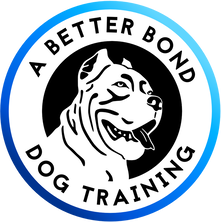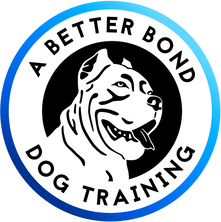Wonder Puppy Program Summary
|
Puppies are always learning, we by our behavior simply dictate WHAT they learn. While we should have fun with our dogs, love and enjoy them, we should also keep this in mind. Ultimately obedience training should help create the best possible relationship between you and your dog. When used as part of your daily life training will help create clarity for both of you, through clearly communicated expectations. This removes so much frustration from our relationship with our dog. Now that your puppy has age appropriate obedience skills it is my sincere hope you will enjoy taking her places with you and doing things that both of you enjoy, safely together. This will be important in teaching her to generalize her new training to other environments. Dogs do not generalize well so the more you take her out to practice her basics the better she will understand what behavior is appropriate. In doing so your dog is also more likely to get the things they, as dogs need with you.Instead of in overwhelming situations like dog parks or hyper interactions with strangers. When we add play and various forms of fulfillment into our lifestyle, as well as this training and some structure we easily promote good behavior in dogs of all ages.
The more calm, consistent and confident we are, the more calm, consistent and confident our dogs become. The more we use training, the less you have to use it.. Over time this like anything else becomes habitual, requiring less guidance and management in most situations. This is where the “magic” starts to happen, because you and your dog have now become a “team” as much as you have been a good “leader” and “teacher”. Just remember your dog is a puppy now, adolescent later and has some time before adulthood. Granted this is a 2-3 year process not 18 years like a person but keep reasonable expectations in mind and be patient. Expectations should match your investment into daily training and lifestyle habits, as well as your dogs age. Tip - remember your dog is a baby, a blank slate and tire easily. Your puppy will only do things because they don’t know better, they aren’t receiving enough guidance or enough supervision. Take advantage of the “baby stage” by reinforcing the things you want them to do for the rest of their lives. The puppy stage or baby stage is over at 6 months, you basically have a toddler. After that you essentially have a teenager until 2 or 3 years of age, depending upon your dog's breed and rate of maturity. What your pup learned! Conditioning to leash pressure- To yield to and follow leash guidance. Beginning understanding to avoid applying pressure on leash. Rule- never move forward when a dog pulls. Either stay still until your dog yields and checks in, go the opposite way or use one of the other techniques covered in our lessons. Conditioning to Starmark walking collar- Pro-Training-Collar-Guide-2011.pdf Conditioning to sit with upward leash pressure- To sit when feeling sustained, light leash pressure. Verbal sit with duration- To follow the verbal cue to sit, with roughly 30 seconds of duration with reasonable guidance. Molded sit - Understanding of light, hands on physical guidance into sit position. Verbal down- To follow the verbal cue to down, with roughly 30 seconds of duration with reasonable guidance. Molded down- Understanding of light, hands on physical guidance into down position. Verbal wait with spatial pressure- To stop moving through a doorway or crate opening when told to wait, reinforcement with reasonable spatial pressure as needed. Verbal Come with guided reinforcement - Verbal cue to come all the way to handler with guidance and reinforcement with long line. Rule - any dogs without formal adult training with solid proofing should only be allowed to run around with a line on uness in a fenced area and only then when the recall is solid in that space. Remember you can’t control every environment but you can bullet proof your training. Introduction to Place- To put all four paws on a surface and remain for short periods with reasonable, present supervision. Additional proofing to be covered in follow up training lessons. Easy - Verbal cue to lighten mouth use when receiving treats, food, resource. Rule - it is better to walk away with a resource and try again later than to allow pushy behavior to pay off, even if it’s just puppy excitement. We get what we reinforce. No conflict resource exchange games- To exchange the item or object the puppy has with one we have which would be of perceived greater value to the dog. Ultimately resulting in the puppy seeking us out to “show” us what they have in hopes of receiving something better. Rule - Never chase a puppy to “take” something, use your training, leash pressure and body language to have them come to you. Handling and grooming practice- Handling of full body. Rule - continuing sessions should be short, always end on a high note when dog is calm and compliant. Acceptance of molding positions are important as we set up dogs up for success in handling vet exams, grooming, being accidentally bumped into by adults, children and more. Informational sources and other exercises- Potty Training Protocol NILF as a lifestyle Raising a balanced puppy Critical Periods in Dog Development Puppy Expectations Chart Additional Starmark links - you need size smalls Additional Videos, training articles and helpful links- Nosework is a wonderful way to get your dog using their brain, give primal fulfillment and really make your dog think you are awesome. I encourage you to give it a try! There are tons of fun ways to do this and no end of videos on YouTube to give you different ideas. You really can’t go wrong, inside, outside and in any weather, work your dogs nose and their brain. Sit on the Dog is an additional exercise that requires almost no effort on your part. A state of mind and impulse control exercise that we regularly did with your dog. It is very helpful in reinforcing your dogs improved manners both at home and in public. Spice up your walks and off leash with Urban agility. Your dog did this often with us to build confidence & their interest in working with us. Climbing over things with your dog is actually a very good relationship builder. I do this all the time to build a dog's trust in me. And it’s fun! https://www.primopads.com Offering our dogs natural, healthy chews in a great stress relief AND by handing your dog something like this, as a reward is another great way to increase your value to your dog. Do not leave this or other high value items down, giving the dog constant access but as a reinforcement of place, crate time etc. We recommend elk antlers . Children and other dogs should never be allowed to bother the dog while they have any high value items. This causes unnecessary conflict and stresses the relationship over time. A healthy will behave better! Although we are not veterinarians we do recommend a whole dog approach to living an enjoyable life with your dog. We recommend choosing a good probiotic which will help in avoiding nervousness as an upset GI directly affects stress and vice versa. We also recommend building and maintaining your dog's immune system with - https://www.nuvetlabs.com/order_new2/products.asp For more recommendations, advice or if you ever need help just reach out! |
What We Cover
Age Appropriate Training skills and age appropriate expectations are important. Puppy training is NOT “finished” training, more training IS NEEDED. |


